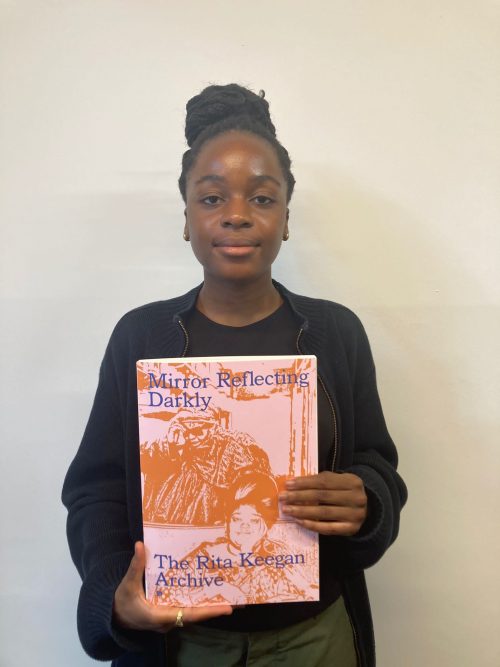
Teloni Thandiwe with publication Mirror Reflecting Darkly: The Rita Keegan Archive’ in Stuart Hall Library, 2022
Our recent archive volunteer Teloni Thandiwe reflects on her time volunteering in iniva’s archives and the development of her approach to archiving.
My encounter with archives throughout my time at university revealed the scarcity of historical records that reflected the experiences that intrigued me. In my study of women’s resistance movements throughout colonial Africa, the lack of women’s perspectives in the records I came across and biased colonial archives revealed the deliberate constructions of incorrect and incomplete histories. Due to this, I sought to collaborate with institutions that were motivated to create, regenerate, record and highlight marginalised histories and how their histories would be preserved. Volunteering in iniva’s archives has been invigorating and has taught me valuable skills, intensified my desire for new knowledge, and enabled me to be a part of defining an archival practice which focuses on reflecting internationalism and preserving the memories of visual artists of African and Asian descent.
I undertook a variety of tasks, starting with repackaging material from artist files to update the archives and the upcoming digitisation project for TaNC (Transforming a National Collection) project with the Institute of Decolonising Art. I explored the background of the artists that I was working with and had to carefully consider what kind of information should be preserved within these files. It also gave me the opportunity to discover artists and unearth more intriguing facts about their practices. I believe that iniva’s archive is vital in shaping the memory of artists, curators, and writers. I admired that iniva aimed for the archive to be a unifying space between the institution and the individual by making sure to approach those who were already in it and ensure they had a say in their remembrance through how their records will be catalogued in the future. In addition to repackaging, I also updated databases of artist biographies such as iniva’s People Directory which required thorough research and created gallery authority records for the new catalogue system, a process which proved to be very engaging. Through this research of exploring countless notable figures and art institutions that related to exhibitions iniva was involved in, I became aware of the laborious yet rewarding work of archiving behind the scenes.
Each task urged me to reflect on how I approach the archive. I had to consider who had the authority in the process of collating its content, how it could be defined and what narrative the material wanted to communicate. It is crucial for archivists to always interrogate themselves at every step of the process and consider their own biases. I evaluated my relationship with the archives as a researcher and how I found myself inside it in relation to representation within visual culture. The work for the digitisation project taught me that the way in which archives are created can greatly influence people’s paths into them. Such deliberations led me to the discovery of Rita Keegan’s artist file and her practice within iniva’s archive.
Rita Keegan, an American-born artist of Caribbean and Black-Canadian descent, was crucial to the development of the British Black Arts Movement. Keegan is also notable for the creation of the Women Artists of Colour Index at Goldsmiths University which archived and recorded the contributions of women artists of colour. Within Keegan’s artist file, The Rita Keegan Archive Project stood out to me because it was my first encounter with a black feminist archival practice. Prior to my discovery, I had only viewed archives in relation to institutions, which were often western, and rarely individuals. Documenting her practice in the book ‘Mirror Reflecting Darkly’, which I found in Stuart Hall Library, she highlights her journey to assembling records from her family, artists, writers and academics. It is clear from the book that she has cherished these creative networks, the traces of her everyday life and the ruptures of the British art world. Keegan’s experiences have revealed the “additional labour required of Black women to achieve adequate representation, as they battle the chronic lack of infrastructure needed to sustain and aid their artistic growth” (Keegan, 2021: 36).
Through its volunteer opportunities, iniva aims to engage communities in the production of contemporary histories because the archive should never be created in isolation but in collaboration with its audience. My time as an archive volunteer at iniva has taught me that the archive is a powerful repository of memory and an active site of discovery. In aiding with its development, I felt that I have contested the marginalisation of certain voices in hope that those who come across the archive can find themselves inside of it.
Biography
Teloni Nkhalamba is currently a final year BA War Studies and History student at King’s College London. She has been volunteering in the archives since March 2022.
References
Keegan, Rita. Mirror Reflecting Darkly: The Rita Keegan Archive (Goldsmiths Press, 2021)